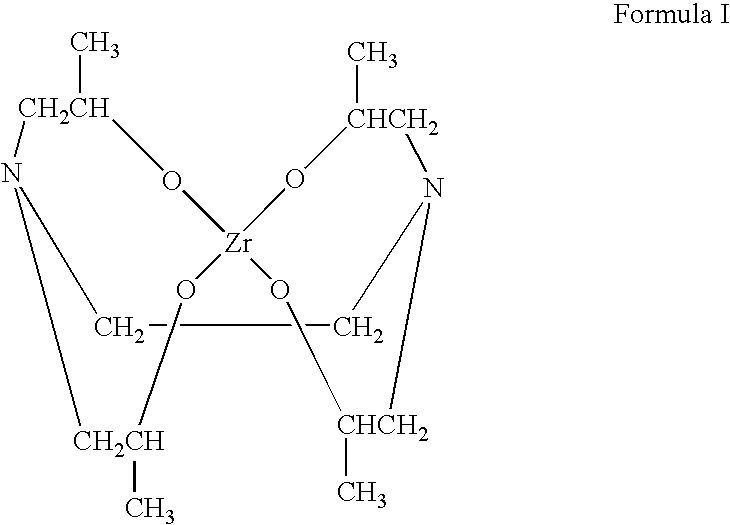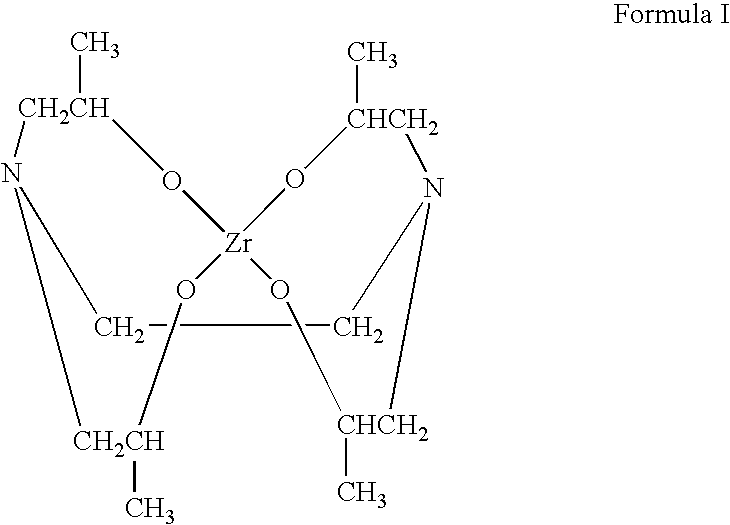Stable solutions of zirconium hydroxyalkylethylene diamine complex and use in oil field applications
a technology of hydroxyalkylethylene diamine and complex, which is applied in the direction of flushing, sealing/packing, and wellbore/well accessories, etc., can solve the problems of inability to recover economically, reduce production rates, and inability to cross-link with known cross-linking compositions, etc., and achieve the effect of effective viscosity generation
- Summary
- Abstract
- Description
- Claims
- Application Information
AI Technical Summary
Benefits of technology
Problems solved by technology
Method used
Image
Examples
examples
[0048]The preparation of the compositions in the Examples and in the Controls were each carried out in closed vessels containing an agitator, thermometer, condenser, nitrogen inlet and dropping funnel. Unless specified otherwise, percentages are given by weight. Temperatures are given in degrees Celsius. The cross-linking properties of the compositions of this invention are given in the Examples as a function of the viscosity of carboxymethyl, hydroxypropylguar cross-linked with the zirconate of this invention.
Control 1
[0049]Triethanolamine (135.2 g) was added to 100 g of tetra-n-propyl zirconate solution (TYZOR NPZ organic zirconate, available from E. I. du Pont de Nemours and Company, Wilmington, Del.). The reaction mixture was heated to 60° C. and held there for 4 hours. Upon completion of the reaction the resultant solution of tetra(triethanolamine) zirconate was concentrated on a rotary evaporator under reduced pressure to yield 155 g of a viscous yellow oil, which contained 13...
example 1
[0053]Tetra-2-hydroxypropyl ethylenediamine, QUADROL polyol, (66.3 g) was added to 100 g of tetra-n-propyl zirconate (TYZOR NPZ organic zirconate) in a 1:1 mole ratio of the diamine to zirconium. The resultant mixture was heated to 60° C. and held there for 2 hr. During the heating period, a white solid separated from the reaction mass. Upon dilution with 4.1 g of water, the solids dissolved. The resultant solution of zirconium complex of tetra-2-hydroxypropyl ethylenediamine was heated an additional 4 hr at 80° C. to give a 170 g of a pale yellow liquid containing 12.1% Zr.
example 2
[0054]Tetra-2-hydroxypropyl ethylenediamine, QUADROL polyol, (66.3 g) was added to 100 g of tetra-n-propyl zirconate (TYZOR NPZ organic zirconate) in a 1:1 mole ratio of the diamine to zirconium. The resultant mixture was heated to 60° C. and held there for 2 hr. During the heating period, a white solid separated from the reaction mass. Upon dilution with 12.3 g of water, the solids dissolved. The resultant solution of zirconium complex of tetra-2-hydroxypropyl ethylenediamine was heated an additional 4 hr at 80° C. to give a 178 g of a pale yellow liquid containing 11.6% Zr.
Preparation of Base Gel
[0055]A Waring blender jar was filled with 1 liter of distilled water. To this was added 2 g of a 50% aqueous solution of tetramethylammonium chloride clay stabilizer. Agitation was started and 3.6 g of carboxymethylhydroxypropylguar (CMHPG) was sprinkled into the vortex of the agitating solution. The pH of the resultant slurry was adjusted to 6 with sodium diacetate and agitation continue...
PUM
| Property | Measurement | Unit |
|---|---|---|
| temperature | aaaaa | aaaaa |
| temperature | aaaaa | aaaaa |
| temperature | aaaaa | aaaaa |
Abstract
Description
Claims
Application Information
 Login to View More
Login to View More - R&D
- Intellectual Property
- Life Sciences
- Materials
- Tech Scout
- Unparalleled Data Quality
- Higher Quality Content
- 60% Fewer Hallucinations
Browse by: Latest US Patents, China's latest patents, Technical Efficacy Thesaurus, Application Domain, Technology Topic, Popular Technical Reports.
© 2025 PatSnap. All rights reserved.Legal|Privacy policy|Modern Slavery Act Transparency Statement|Sitemap|About US| Contact US: help@patsnap.com


